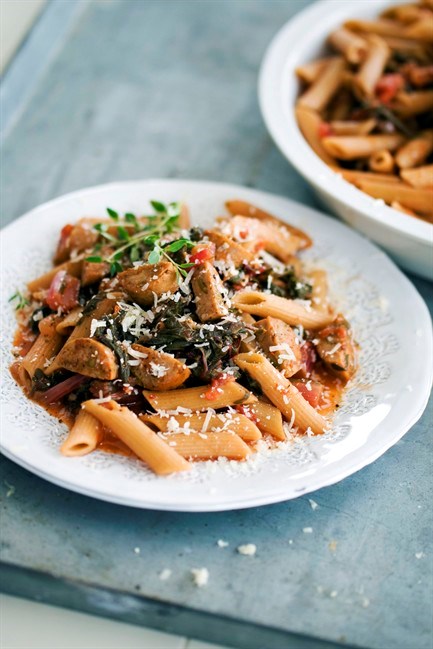No matter how unimpeachable whole-wheat pasta is in terms of nutritional cred, I've always found it off-putting.
Sure, it has more fiber and whole-grain nutrition. But it always struck me as rather spineless and dull. And as someone whose culinary credo is that food can be scrumptious and healthy, I wasn't about to eat whole-wheat pasta for its nutritional benefits alone.
Happily, several brands recently have developed very respectable lines of 100 per cent whole-wheat pasta. If you haven't lately, you might want to taste a few of them to decide which is your favourite.
Once you've settled on a winner, cook it the way I suggest in this recipe, which is to finish cooking the pasta in the sauce. This produces a more flavourful dish than the more traditional method — cooking the sauce and pasta separately, then combining them only at the last minute. Plenty tasty, but the flavours never marry.
I learned a better way years ago when New York chef and restaurateur Scott Conant (his mom is of Italian descent) was my guest on "Cooking Live." Transfer the pasta before it's fully cooked to the sauce, then let it simmer in the sauce until it's done. This way the pasta absorbs the flavour of the sauce and becomes that much tastier.
If you also add a little of the pasta cooking liquid to the sauce, it will work to glue together the pasta and sauce in a most satisfyingly connubial fashion.
And let's not forget our Swiss chard. A spring vegetable, this tangy Mediterranean member of the beet family comes in several colours, from bottle green to rainbow. And it's edible from tip to toe, too, stems included. Just slice the stems and put them in the pan before the greens, because they take a little longer to soften.
By the way, if you're wondering how the heck you're going to persuade a full pound of greens to cook down within the confines of a single skillet, don't worry; the water that clings to the greens after you wash them will help them to wilt. Just add them a handful at a time. Besides chard, this dish also would provide a happy home for spinach, beet greens, or any other greens.
To finish, I pepped up the greens with a little chicken sausage, but just a little and just for flavour. Plenty of cultures use animal protein this way, rather than relying on a substantial slab of it to occupy the centre of the plate. There's a lesson there for us: it's better for our health and for the environment.
This is pretty much a one-dish meal. Serve it with a nice little tossed salad on the side and a glass of vino, and savour your contentment.
___
WHOLE-WHEAT PENNE WITH SPRING GREENS AND SAUSAGE
If you have trouble finding Swiss chard, you can substitute spinach. Discard any tough spinach stems and use the leaves as directed.
Start to finish: 45 minutes (15 minutes active)
Servings: 4
8 ounces whole-wheat penne
1 pound Swiss chard
2 tablespoons extra-virgin olive oil
4 ounces chicken sausages, halved lengthwise, then sliced 1/2-inch-thick crosswise
1/2 cup finely chopped yellow onion
2 cloves garlic, minced
Kosher salt
15-ounce can (about 1 3/4 cups) chopped tomatoes, preferably fire roasted
1/2 teaspoon red pepper flakes (optional)
1 1/2 ounces grated Parmigiano-Reggiano cheese
Bring a large pot of salted water to a boil. Add the pasta and cook for a few minutes less than the recommended time on the box.
Meanwhile, cut off and reserve the Swiss chard stems. Chop the Swiss chard leaves coarsely. Cut the stems into 1/2-inch lengths.
In a large skillet over medium-high, heat the oil. Add the sausages and cook, stirring, for 3 minutes, or until lightly browned. Use a slotted spoon to transfer the sausages to a bowl.
Return the skillet to medium heat and add the onion. Cook until golden, 3 to 5 minutes. Add the garlic and cook, stirring, for 1 minute.
Add the Swiss chard stems to the skillet, cover and cook for 3 minutes. Remove the lid and add half the Swiss chard greens. Stir and cook, stirring occasionally, until the greens are slightly wilted. Add the remaining greens, cover and cook, stirring occasionally, until completely wilted. Add the tomatoes, a hefty pinch of salt and the red pepper flakes, if using.
When the pasta is almost done but not quite al dente, drain it, reserving 1 cup of the cooking liquid. Add the pasta and 3/4 cup of the cooking liquid to the skillet and simmer for 3 to 4 minutes, adding more cooking liquid if necessary, until the pasta is al dente and most of the liquid has evaporated. Add the sausages, then season with salt. Divide the mixture among 4 shallow bowls and top each portion with some of the cheese.
Nutrition information per serving: 380 calories; 110 calories from fat (29 per cent of total calories); 12 g fat (3 g saturated; 0 g trans fats); 20 mg cholesterol; 55 g carbohydrate; 8 g fiber; 6 g sugar; 19 g protein; 950 mg sodium.
___
EDITOR'S NOTE: Sara Moulton was executive chef at Gourmet magazine for nearly 25 years, and spent a decade hosting several Food Network shows. She currently stars in public television's "Sara's Weeknight Meals" and has written three cookbooks, including "Sara Moulton's Everyday Family Dinners."



